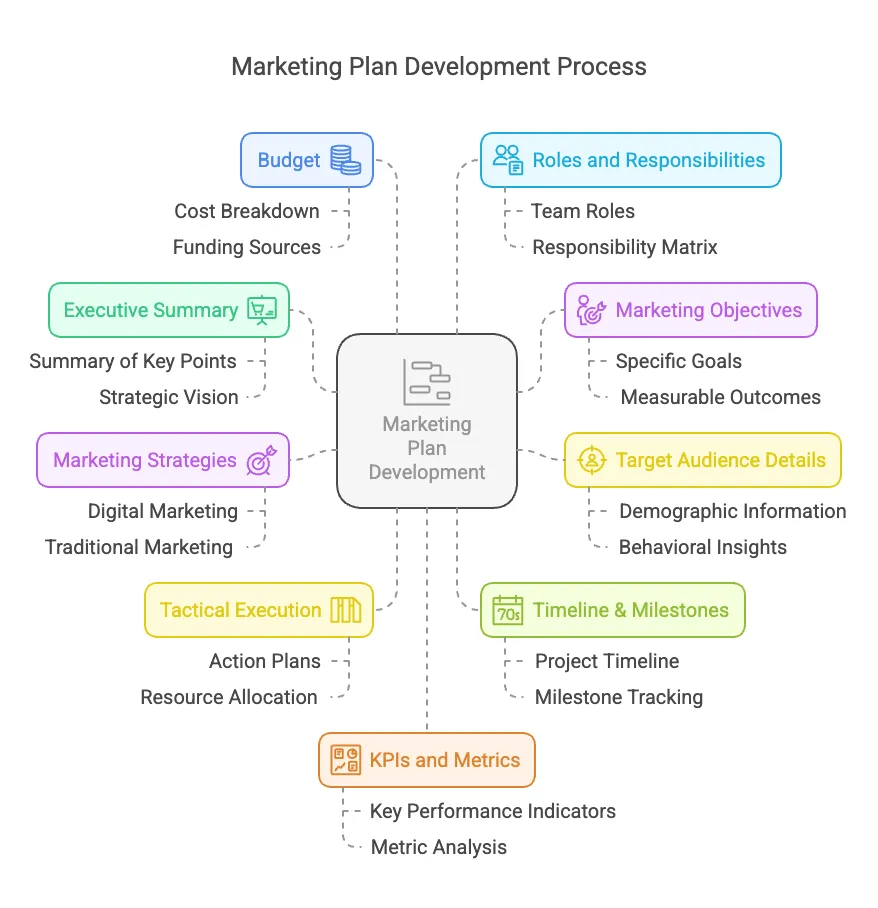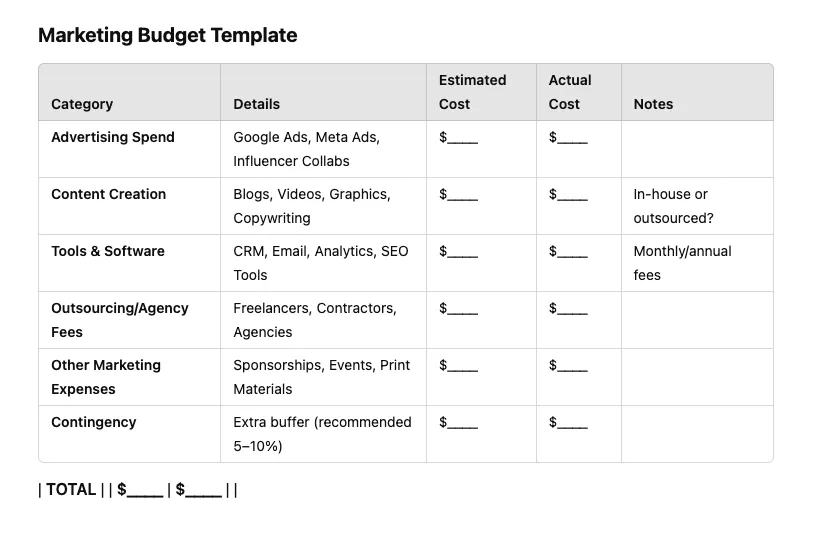
Why Create a Marketing Plan? To Stop Guessing and Start Scaling.
Without a plan, it’s easy to waste time and money on the wrong things. A solid marketing plan gives you a roadmap—and when paired with automation, it becomes a system that works even when you’re not online. You'll attract the right leads, stay consistent across platforms, and build real momentum toward growth.
Here’s what a typical Marketing Plan might look like:
• Step 1: Tactical Execution
• Step 2: Timeline & Milestones
• Step 3: Budget
• Step 4: Roles and Responsibilities
• Step 5: KPIs and Metrics
• Step 6: Contingency Plan
Step 1. Tactical Execution:
This section outlines the day-to-day marketing efforts that bring the strategy to life. Each campaign is built to support your core objectives, with a content plan that maps out what to say, where to say it, and how often. Paid advertising covers platforms, budgets, and reach goals to drive visibility fast. The SEO plan focuses on targeted keywords and technical improvements to boost organic traffic. Social media efforts are structured around consistent posting, engagement, and platform-specific content. Email marketing ties it all together—keeping your audience informed, nurtured, and ready to act.
CAMPAIGNS:
Detailed description of each campaign designed to meet objectives.
CONTENT PLAN:
Topics, formats, frequency, and platform for content (e.g., blog posts, social media, videos).
PAID ADVERTISING PLAN
Platforms (Google Ads, Facebook, Instagram, etc.), budgets, and expected reach.
SEO PLAN:
Keywords to target, on-page and off-page SEO tactics.
SOCIAL MEDIA PLAN:
Platforms to use, type of content, engagement strategy, and posting schedule.
EMAIL MARKETING PLAN:
Frequency, segmentation, and type of emails (newsletters, drip campaigns, promotions).
Step 2. Timeline & Milestones:
This section maps out the entire plan over time, so nothing gets missed and progress stays on track. It includes a clear schedule of campaigns, content deadlines, ad launches, and review points—organized by quarter or year. Whether you use a calendar or Gantt chart, the goal is to keep execution aligned, accountable, and easy to follow.
LAUNCH DATES:
Launch dates mark when key campaigns, content pieces, or promotions go live. They’re set in advance to keep your team aligned and your marketing consistent. Each date is tied to a specific goal—so you’re not just launching to launch, but to make an impact.
DEADLINES FOR CONTENT
Content deadlines keep your team on track and ensure everything gets published on time. From blog posts to social media, setting clear due dates helps avoid last-minute stress and keeps your message consistent.
AD CAMPAIGN LAUNCHES
Ad campaign launch dates are planned to maximize visibility and performance. Whether it’s a seasonal promo or an always-on campaign, these launches are timed to align with your goals and audience behavior.
REVIEW POINTS
Review points are built-in checkpoints to evaluate what’s working, what’s not, and where to adjust. These are scheduled regularly—monthly, quarterly, or after major campaigns—to keep your strategy sharp and results-driven.
Step 3. Budget:
This section breaks down the costs behind every part of the plan—from ad spend and content creation to tools, software, and outsourcing. It helps make sure your marketing strategy is not only effective but realistic, aligning with your available resources while still aiming for growth. No surprises—just smart, intentional spending.
Advertising spend (PPC, social media ads, influencer campaigns)
Content creation (blog, video, design, etc.)
Tools and software (CRM, email marketing platform, etc.)
Outsourcing and agency fees (Freelancers, contractors, agencies)
Other marketing expenses (e.g., event sponsorships)

Step 4. Roles and Responsibilities:
This section outlines who’s doing what—so nothing falls through the cracks. From content creation and social media to campaign management and reporting, each task is assigned to the right person or team. Clear ownership keeps the plan moving, ensures accountability, and makes collaboration smoother across the board.
Content creation (internal team or outsourced writers/designers)
Social media management
Campaign management (PPC, email marketing, etc.)
Analytics and reporting
Step 5. KPIs and Metrics:
To know what’s working, you have to measure it. This section outlines the key performance indicators (KPIs) tied to your goals—like website traffic, conversion rates, ad performance, and email engagement. Tracking these metrics regularly helps you stay focused, make informed decisions, and adjust strategies to get better results over time.
Common KPIs include:
Website traffic (organic, paid, referral)
Conversion rate (from website visitors, email campaigns, or ads)
Cost per lead/acquisition
Social media engagement (likes, shares, comments)
Email open rates and click-through rates (CTR)
Return on Ad Spend (ROAS)
Step 6. Contingency Plan:
Not everything goes according to plan—and that’s okay. This section outlines what to do if a tactic or campaign underperforms. Whether it’s shifting budget, adjusting messaging, or switching platforms, having a backup plan in place means you can pivot quickly without losing momentum or wasting resources.
Backup Strategies for When Things Don’t Go as Planned
REALLOCATE BUDGET:
If a paid channel isn’t performing (like Meta ads or Google Ads), shift spend to the one that is. Don’t keep funding what isn’t converting.
REFRESH CREATIVE OR MESSAGING:
Underperforming content? Test a new hook, headline, or visual. Sometimes a small tweak makes a big difference in engagement.
ADJUST TARGETING:
If you’re not reaching the right people, refine your audience—by location, interests, behavior, or demographic. Better targeting leads to better results.
CHANGE THE OFFER:
If no one’s biting, the offer may not be compelling enough. Repackage it, add urgency, or test a lower-friction option like a freebie or trial.
DOUBLE DOWN ON WHAT IS WORKING:
Shift focus and resources to the channels or content types performing best. Ride the momentum instead of fighting resistance.
RUN A RAPID TEST:
Set up a quick A/B test to compare versions of a landing page, email, or ad. Use the data to guide your next move.
PAUSE AND REVIEW:
If nothing is landing, hit pause. Reassess your data, revisit your goals, and make strategic adjustments rather than reacting blindly.
Want to know more? Let's Talk!
I’d love to meet you, hear about what you’re working on, and see how I can help support you.


Facebook
LinkedIn